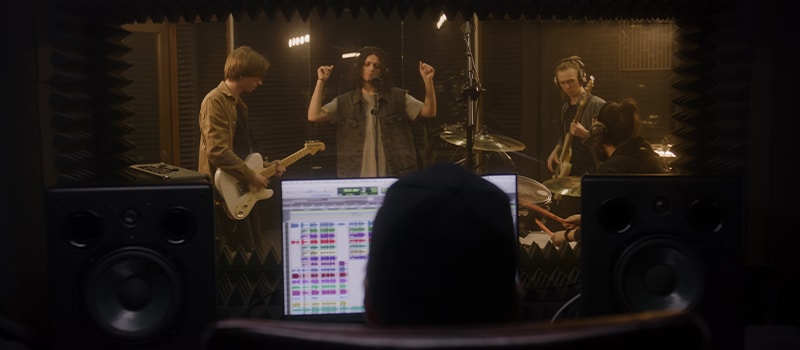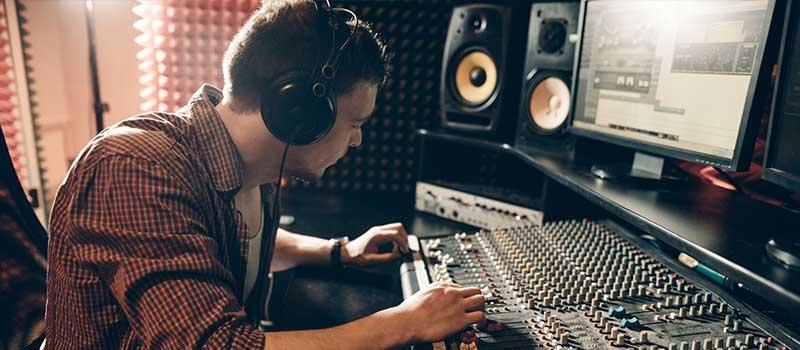You know it when you hear it.
The power of audio branding is unmistakable.
From the Netflix audio logo, to Coke’s “Holidays are comin’” jingle…
It’s a sensory experience that evokes emotion and immediately transports you in a way that other communication simply can’t compete with.
Audio branding is without doubt on of the most powerful ways to establish memorability, recall and familiarity, all of which of course earn trust.
In this article, you’ll discover the power of audio branding and how you can use it to get into the ears, minds and hearts of your target audience.
The Science of Sound in Branding

You know how a particular sound or tune can suddenly make you remember a product or a brand? That's not magic, it's science.
Our brains have a unique way of linking sounds to memories and emotions. For brands, this is super useful.
Choose the right sound, and you've got a powerful tool that can make people think of your brand just by hearing a few notes. Like hearing a familiar theme song and instantly feeling good.
Examples Of Memorable Brand Sounds:
McDonald’s: “I'm Lovin' It” jingle.
Intel: Their distinct four-note bong.
Nokia: The iconic Nokia ringtone.
How To Create An Audio Brand Identity

Creating your audio brand identity is about giving your brand a voice that matches its personality. Is your brand upbeat and energetic or more on the serious side? Your audio choices should reflect this.
Remember, consistency is key.
Your brand's sound should be recognizable and consistent, whether it's in an ad, on your website, or at an event.
It’s all about making your brand sound like a friend your customers would want to chat with.
Key Considerations:
Brand Personality: Is your brand fun and playful or sleek and professional?
Target Audience: What kind of sounds does your audience resonate with?
Consistency: Ensure the sound is consistent across all platforms.
PRO Brand Strategy BluePrint
Build Brands Like A Pro Brand Strategist

How To Create Sonic Branding Elements

When it comes to picking the sounds for your brand, it’s more than just the music.
It's about the voice in your ads, the sound effects in your videos, and the rhythm of your jingles.
Each element needs to fit well together. Say your brand is adventurous – you might want a bold voice and lively music. It's about creating a sound combo that makes people instantly think of your brand.
How to Choose and Where to Find These Elements:
Music:
Look for tunes that match your brand’s energy. Royalty-free music libraries are a good start.
Voice:
Choose a voice that reflects your brand’s personality. Consider professional voice actors.
Sound Effects:
Use effects that enhance, not overpower, your message. Sound effect libraries can be helpful.
How To Ensure Sonic Consistency Across Media

Sonic consistency is like your brand's signature tune — it needs to be the same, whether it's heard on a TV commercial, a radio spot, or in an online ad.
This consistency of style is what builds recognition and trust among your audience. Think of it as the audio version of your logo; it should be instantly identifiable, no matter where your audience encounters it.
Detailed Tips for Maintaining Consistency:
Develop Comprehensive Audio Brand Guidelines:
Just like visual branding, audio branding needs a set of guidelines. These should outline the use of music, voice, tone, pace, and sound effects across different media.
Quality Control Across Platforms:
Regularly audit your audio branding across different platforms. This ensures that the sound quality is high and consistent, whether it's streaming through headphones, speakers, or in-store sound systems.
Adapt While Maintaining Core Elements:
While keeping the core sound elements consistent, it's essential to adapt them to fit various contexts and platforms. For instance, the audio branding in a YouTube ad might need to be more attention-grabbing than in a podcast.
Audio Branding in Marketing Strategies

In today's digital age, audio branding is a potent tool in your marketing arsenal.
It can give your brand a distinctive edge in various channels, from podcasts and radio ads to social media and beyond.
Audio branding can be particularly effective in environments where visual branding is limited or absent.
Strategies for Incorporating Audio Branding:
Leverage Podcasts:
With the rising popularity of podcasts, consider creating a branded podcast that aligns with your brand values, or sponsor episodes relevant to your audience. This not only enhances brand recall but also connects with listeners on a personal level.
Social Media Integration:
Social media platforms are increasingly embracing audio (think Instagram stories with voiceovers and music). Integrating your audio branding elements here can enhance user engagement and brand recall.
Audio-Driven Advertising:
In advertising, whether it's online, radio, or TV, ensure your unique audio elements are front and center. This creates a cohesive brand experience across various touchpoints.
Case Studies: Successes in Audio Branding

Exploring less clichéd, yet impactful case studies of audio branding reveals the depth and potential of this strategy.
Let's take a look at two such examples:
Spotify: Crafting a Personalized Audio Identity

Spotify, a leader in digital music streaming, has taken audio branding to a new level. The essence of their audio branding lies in personalization.
They didn't just create a single sound; they developed a dynamic sound identity that changes based on user interaction and time of day.
Behind the Scenes:
Idea Origination:
The concept was to mirror their service's personalization – every user's experience is unique, so why shouldn't their audio branding be?
Production Process:
Spotify used advanced algorithms to create a fluid sonic identity. This involved composing various musical elements that could be rearranged programmatically.
Brand Impact:
This innovative approach reinforced Spotify's brand as cutting-edge, user-focused, and dynamic. It significantly boosted user engagement, as the personalized sound experience made users feel more connected to the brand.
Explore Brand Strategy
Programs & Tools
Intel: An Iconic Sonic Logo

Intel’s four-note sonic logo is one of the most recognizable sounds in the tech world. It's a brilliant example of how a simple sound can become synonymous with a brand.
Behind the Scenes:
Idea Origination:
The goal was to create a sound that conveyed reliability and innovation, resonating with Intel’s brand values.
Production Process:
The sound was meticulously crafted, with each note representing an aspect of the Intel brand. The choice of instruments and tempo was carefully considered to evoke a sense of technological sophistication and trust.
Brand Impact:
Intel's sonic logo has played a crucial role in its branding strategy. It not only increased brand recall but also helped position Intel as a trustworthy and innovative leader in technology. The sound is so iconic that it often plays in people's minds when they see the Intel logo.
These examples show the power of well-crafted audio branding in enhancing brand recognition and creating an emotional connection with the audience.
By focusing on their unique brand values and audience, both Spotify and Intel have set a high standard in the audio branding realm.
Evaluating Your Audio Brand's Impact

To truly understand how your audio branding influences your brand, it's important to measure its impact meticulously.
It's more than just having a catchy tune; it’s about how that tune reinforces brand recognition and loyalty.
In-Depth Evaluation Strategies:
Brand Recall and Recognition:
Utilize surveys and focus groups to gauge if your audience can identify your brand from the audio elements alone. This could involve playing just the audio element without any visual cues and asking participants to name the brand.
Analyzing Engagement Metrics:
Scrutinize how your audio-branded content performs across different platforms. Are your audio-branded social media posts getting more engagement? Do your video ads with the audio branding have higher view rates or longer watch times?
Correlation with Sales and Marketing Performance:
Keep a close eye on sales figures, website traffic, and other relevant marketing metrics before and after implementing your audio branding. Increases in these areas can be a strong indicator of effective audio branding.
Customer Feedback:
Direct feedback from customers can provide invaluable insights into how your audio branding is perceived and its impact on customer experience.

While audio branding offers significant benefits, it comes with its own set of challenges. Understanding and preparing for these can ensure smoother implementation.
Addressing Common Challenges:
Legal Hurdles:
When selecting music or sounds, it's crucial to navigate copyright laws carefully. This means either using original compositions or ensuring you have the right licenses for pre-existing music.
Aligning Audio with Brand Identity:
One of the trickiest parts can be ensuring your audio branding aligns seamlessly with your brand’s existing identity and values. This may require extensive testing and iteration to get just the right tone, voice, and music.
Integrating Across Channels:
Consistency across all channels – from digital ads to physical stores – is crucial. This can be challenging, especially when dealing with diverse platforms with different audio requirements and user experiences.
Adapting to Market Changes:
The world of audio branding is dynamic, and what works today might not work tomorrow. Staying attuned to trends and being ready to adapt is crucial.
Anticipating the Future of Audio Branding

As we venture further into the digital age, the role of audio in branding is set to grow exponentially.
Staying ahead of these trends will be key for brands looking to make a lasting impact.
Emerging Trends and Future Directions:
Voice-Activated Interactions:
With smart speakers and voice assistants becoming commonplace, brands will need to think about how their audio branding works in a spoken context. This isn’t just about recognition but also about how well the brand's voice interacts with users.
3D and Spatial Audio:
Advances in audio technology, like spatial audio, offer new ways for brands to create immersive experiences. This can be particularly impactful in virtual and augmented reality settings.
Hyper-Personalization:
Taking a cue from brands like Spotify, there’s potential for more nuanced and personalized audio experiences, tailored not just to demographic groups but to individual preferences and behaviors.
Over To You
In summing up, audio branding is much more than an auditory logo or a catchy jingle; it’s a crucial part of your brand's identity.
It requires thoughtful integration into your overall brand strategy, consistent application across all media, and adaptability to evolving technologies and consumer preferences.
When done right, it can elevate your brand, creating deeper emotional connections with your audience and setting you apart in a crowded marketplace.
FAQs
1. What is audio branding?
Audio branding, also known as sonic branding, is the use of sound to reinforce brand identity. It’s like a musical signature that helps people recognize and remember a brand. This can include jingles, voiceovers, sound logos, and other sound elements.
2. Why is audio branding important?
In a world where consumers are bombarded with visual information, audio branding cuts through the noise. It engages people on a different sensory level than visuals, creating a more memorable and emotional connection with the brand.
3. How does audio branding impact customer behavior?
Audio branding can significantly enhance brand recall and recognition. A distinctive sound or jingle can trigger instant brand recognition and even influence purchasing decisions. It’s a powerful tool for brand communication and for building brand loyalty.
4. Can small businesses benefit from audio branding?
Absolutely! Audio branding isn’t just for big corporations. Small businesses can use this form of audio branding to stand out, especially in local markets or specific niches. It’s an affordable and effective way to enhance brand recognition.
5. How long should an audio logo or jingle be?
An audio logo or jingle should be brief yet memorable. Typically, they last between 3 to 5 seconds. The key is to make it long enough to convey the brand or company's personality or essence but short enough to be easily recalled.






